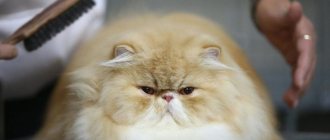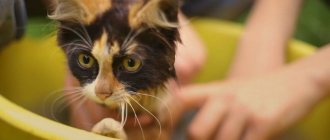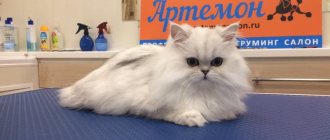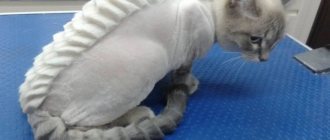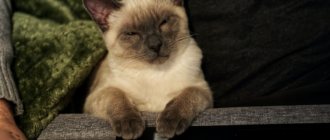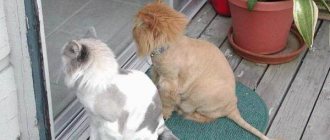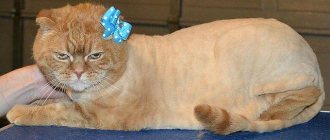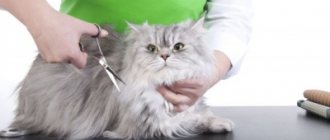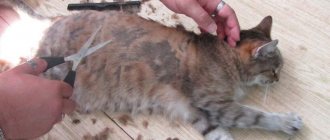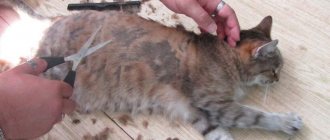Currently, grooming pets, particularly cats, is becoming increasingly common and popular. In a professional environment, cat grooming is called “grooming” and is usually done by a professional groomer. Grooming cats - 85 photos of professional cat grooming in our selection.
Every cat owner must constantly take care of their pet and monitor its appearance. Grooming an animal consists not only of regular bathing, trimming nails or combing, but also of bringing the fur into the appropriate shape.
For any cat, such procedures are often necessary not only to improve their appearance, but it is not uncommon that they are important for the life of the pet.
Depending on the temperament and character of the cat, you may be faced with the fact that it is not possible for owners to groom cats at home, and it is also necessary to use special tools for grooming cats.
Often, many cats react aggressively to such procedures and may even attack the owner. In such cases, professional groomers who have sufficient experience and skills in grooming cats at home or in a salon come to the rescue.
The described procedure is carried out in many veterinary clinics or, as has become popular nowadays, in specialized animal salons, where they also use cosmetics for grooming cats. See cat grooming in the photo gallery:
Creative haircut
There are no clear rules here. Everything is limited by the imagination of the owner or groomer. You can create any pattern from wool: make waves, stripes, twisted lines. Moreover, the patterns can be on the body or tail or everywhere at once.
The groomer can offer to cut any shape: bow, stars, etc.
Before you decide on such a haircut, think about whether you really need it. The animal doesn't really need patterns. Shortening the length will be enough for him. It often happens that creative grooming disfigures the appearance, you will have to get used to the strange appearance of your pet.
Fatigue is a great helper
Few owners know that before grooming, it is necessary to make the cat tired or try to distract him so that the procedure takes place in a calm atmosphere. There are several ways to do this:
- Animals love toys, for example, soft pillows, threads, strings and other interesting devices. When grooming at home, you can use different objects to distract the animal. The cat will hold the toys with its paws, paying almost no attention to what is happening.
- During passive play, the pet can allow a haircut without anesthesia, remove claws and carry out other necessary manipulations. The main thing is to carefully monitor changes in the cat’s behavior, because toys can quickly get boring, and he will become aggressive not only towards the hairdresser, but also towards the owner.
- The owner can try to make the pet very tired so that the haircut does not have a negative impact on the cat’s psyche. For example, you can play with the animal for a long time or feed it generously. When the cat lies down to sleep, you need to wait about 10 minutes and then begin manipulation. A tired cat can easily tolerate the procedure with a clipper and scissors, however, it will be problematic to completely trim the animal in one go. You will have to eliminate excess hair in several stages.
Pros and cons
As mentioned above, there are undoubtedly benefits from grooming cats. This includes relieving the animal of unpleasant sensations caused by the tightening of the skin by tufts of matted hair, alleviating the pet’s condition in the heat, and significantly reducing the amount of hair in the house during the cat’s molting. The latter is especially true for owners suffering from allergic reactions to animal fur, as well as for young children.
In addition, a haircut significantly transforms and ennobles even the most ordinary-looking cat and turns it into a beautiful and graceful animal.
However, in addition to the obvious benefits, haircuts also have their disadvantages. One of the most important negative aspects is a violation of the thermoregulation of the animal’s body, due to the fact that rough interference occurs in the natural skin conditioning mechanism provided by nature. As a result, after removing part of the fur, the animal’s body temperature changes, and it becomes vulnerable to drafts and direct sunlight.
Another weighty argument against cutting is the deterioration in the condition of the coat after regrowth. There are frequent cases of noticeable degradation of the hair structure and changes in color. But this is not the main thing, since the most dangerous consequence of cutting cats is the extreme stress that most animals experience, especially those getting their hair cut for the first time. After the procedure, many pets become seriously depressed and often become ill due to nervousness. It is also worth mentioning here the known cases of animals dying from cardiac arrest during shearing.
However, for the sake of fairness, it should be noted that such cases are isolated, and most animals quickly recover from fright and live their previous lives.
Considering the disadvantages, it is impossible not to mention that cats grow overgrown rather slowly, and there is no guarantee that the hair after shearing will ever reach its original length. Moreover, in the first few weeks after cutting, the hairs will remain quite prickly and not very pleasant to the touch. With very short haircuts, performed with attachments of 1 mm in length, the risk of damage to the pet’s skin during scratching increases significantly.
Therefore, cutting cats too short is very harmful and risky, and most of the problems that arise due to the animal’s long hair can be solved with regular grooming and thorough combing.
Why and why you need a haircut
All modern pet owners will sooner or later be faced with the question: does their pet need a haircut? If owners of short-haired cat breeds can ignore this issue, then those who have a long-haired pet will need to seriously think about it. The health and appearance of the pet will depend on whether the owner decides to trim the cat or not. This paragraph will discuss the reasons why long-haired cats need regular visits to the groomer.
Decorative design of wool
Wool is falling off
The first and main reason why owners of long fur coats require special care is the risk of matted fur. In this state, it does not allow air to pass through and is a thick lump of hair.
Causes of wool matting:
- lack of proper care from the owners. It is worth remembering that wild cats do not have long hair and can groom it on their own. But representatives of long-haired breeds bred by breeders require the help of their owners. In hard-to-reach places, you need to comb the fur coat manually;
- parasites. If the animal is not treated for parasites in time, it will constantly itch. In this case, cats usually lick the paw with which they itch. Saliva promotes gluing and matting of hair into lumps;
- foreign body. It is important to regularly check the surface of the animal's body for the presence of foreign objects. Often, an accidentally tangled blade of grass causes tangles to form.
At the initial stage, matted hair can be combed with a cat trimmer. In more advanced cases, the only option is to trim or shave off the matted area of fur.
Formation of tangles
Mats are dangerous for a number of reasons. They tighten the fur, causing discomfort to the animal. Trying to get rid of the irritant, the cat can tear the skin, which can lead to blood poisoning. Also, tangles are an environment in which parasites and microbes can live comfortably.
What mats on wool look like
Even kittens are susceptible to tangles. Already in a couple of months they grow very long fur. If the mother cannot lick the kitten thoroughly enough, and the owner does not take measures to care for its fur, the formation of mats is inevitable. The animal will try to get rid of them, and the fur that gets into its fragile body will pose a serious danger. Therefore, you can cut your cat’s hair even at a young age.
Why do cats get their hair cut?
There are two main blocks of reasons why owners cut their pets' hair:
- Hygienic – for health and well-groomed appearance.
- Aesthetic – for beauty.
Hygienic cat grooming
This is rather a necessity - this haircut is most often done on long-haired and fluffy cat breeds.
Why give your cat a hygienic haircut?
- to normalize the thermoregulation of the cat’s body - long and thick hair, especially in the summer, contributes to severe overheating of the animal;
- to help sick and elderly animals who do not care enough for their fur - haircuts save cats from matted and very matted fur;
- to rid the cat of pellets and tangles - matted fur tightens the skin, impairs blood circulation, causes itchy skin and discomfort in the cat;
- hygienic hair cutting is indicated for some skin and parasitic diseases;
- in case of increased secretion of glands, including paraanal glands, it is recommended to trim the area around the genitals;
- for long-haired breeds, the area of the “panties” and under the tail is trimmed to prevent excrement from sticking;
- trimming helps reduce the number of bezoars – hairballs that form in the cat’s gastrointestinal tract;
- cats with prolonged and heavy shedding are clipped to keep the house clean;
- before performing medical procedures on the skin;
- Long-haired cats are clipped if their fur becomes very matted.
Aesthetic cat grooming
This block of reasons includes those that are not a necessity for the animal. This is rather a whim of the owner, a desire to stand out.
Why do aesthetic cat grooming?
- before exhibitions and competitions in which there is a nomination for “Best Haircut”;
- before a photo shoot of an animal to get unusual pictures for Instagram;
- cats with interesting body patterns have their fur trimmed along the line of the pattern to emphasize the natural pattern;
- Extravagant cat owners give their pets fashionable haircuts to match their owner's image.
Important!
If your cat doesn't have a particular need for grooming, leave it alone. Do not interfere with wool to perform its protective functions.
What to consider if you decide to trim your cat
- Grooming is stressful for the animal, so it is best to refuse it unless there are clear indications (state of health, coat or exhibition).
- If necessary, ask the groomer about the possibility of sedation (use of anesthesia). Don't forget to check this with your veterinarian first and inquire about the groomer's medical background.
- It is best if a specialist from a grooming salon comes to trim your pet at home. This is especially important if the cat is nervous and does not like the grooming procedure. A familiar home environment has a calming effect on your pet.
- In some cats, after clipping, the coat may change color and texture, for example, becoming darker and thinner. Keep this in mind and do not cut cats with color point and tipping colors.
- There are cases when an animal’s fur takes a very long time to grow back to its full length or does not grow back at all. Possible sudden color change.
- It is not recommended to cut the hair on the animal's head, whiskers and eyebrows - this can damage the whiskers.
- You cannot completely cut the hair from the tail - leave the hair at ⅓ of the length. Cats love to chew their tail, thereby causing wounds to themselves.
- In the area of the fingers and lower joint of the limbs, you need to leave “socks” made of wool. Their length may vary.
- Before grooming, a cat needs to trim its claws to avoid wounds and scratches not only for the owners and groomer, but also for the pet itself.
- The frequency of haircuts depends on the condition of the coat and the health of your pet; usually cats are cut 2-3 times a year.
- The ideal nozzle for a clipper used to cut a cat’s hair is 3 mm. When using it, the trimmed fur will be soft and will not cause discomfort to the cat. If you use a 1 mm nozzle, the fur will be prickly for the first week - pets don’t like this.
- It is unacceptable to shave cats' heads. They have very delicate skin. A hairless cat can injure itself simply by scratching itself. Animals that go outside can get sunburned.
- It is not recommended to remove tangles with scissors - this can injure the skin. To prevent this from happening, they cut it with a clipper or use a fine-tooth comb (comb) under the tangle, and only then carefully cut it off.
- Exhibition animals are allowed to be groomed 3-6 months before the exhibition.
Where is it better to cut a cat's hair - in a salon or at home?
Whether you take your pet to a professional groomer or cut it yourself is up to you. We will look at the pros and cons of both options, and tell you what points you need to pay attention to.
Cat grooming in professional grooming salons
Let's start with the fact that during grooming in a salon, a specialist examines the cat and assesses the condition of its fur. The groomer can give recommendations on coat care, recommend cosmetics and vitamins for the skin and coat. The entire process takes place in a specially equipped place, which is also one of the advantages of this option.
The disadvantages include the high cost of a professional haircut and the stress that the cat experiences when it is taken to the salon. In order not to expose the animal to unnecessary stress, you can invite a specialist to your home.
Haircut under anesthesia
Some owners want to reduce discomfort for the cat and protect themselves and the groomer from cat revenge. To do this, they resort to anesthesia. There are also inexperienced groomers who are not very good at handling cats.
When grooming cats, injections of muscle relaxants are used as anesthesia. Under the influence of these drugs, the cat becomes immobilized, but does not lose consciousness.
Advantages of haircuts under anesthesia:
- the animal does not interfere with the process;
- no need to hold the animal, trim its claws, bandage its paws, or put on an Elizabethan collar;
- there is no risk that the animal will injure itself, its owners or the groomer;
- the groomer does his job faster.
Disadvantages of cutting hair under anesthesia:
- the animal does not lose consciousness, hears and sees everything, experiences panic at this moment;
- the injection and the haircut itself should be done by a specialist with veterinary or medical education;
- It is imperative to weigh yourself before anesthesia to calculate the appropriate dosage of the drug;
- It is advisable to first be examined by a veterinarian and have a cardiogram done;
- if the dosage of anesthesia is exceeded, paralysis of the diaphragm and intercostal muscles occurs - breathing difficulties arise, cardiac arrest is possible;
- To recover from anesthesia quickly and safely for the pet’s health, it is necessary to give another injection, otherwise the cat will recover from anesthesia within 24 hours;
- If you give a cat a haircut several times under anesthesia, haircuts without anesthesia will be unavailable to her - the animal remembers its panic and sensations and closely associates them with the grooming process.
Video:
Haircut without anesthesia
Grooming without the use of medications is considered less dangerous for the animal, since anesthesia is always a risk, the result of which cannot be programmed.
Advantages of haircut without anesthesia:
- the animal is fully conscious and does not lose mobility - it feels more confident;
- an experienced groomer knows how to approach a cat and calm it down without violence;
- there is no risk of side effects of muscle relaxants;
- the animal trusts the specialist more;
- The cat quickly gets used to the procedure and learns to tolerate it calmly.
Disadvantages of cutting hair without anesthesia:
- may take longer;
- in some cases, additional fixation of the animal and the use of a veterinary collar are necessary;
- There is a risk of a person being injured by a cat.
Video:
When is a cat's haircut necessary?
There are situations when a four-legged friend really needs to cut his fur coat. Let's look at the main ones:
When a cat has a large number of mats of different sizes. Combing the animal in such cases may not always give results, since the tangles very quickly form dense wool balls, which are easier to cut out. In addition to being unsightly, tangles cause discomfort and health problems for your pet. By tightening the skin, they interfere with blood flow and cause itching. After all, by their nature, cats are very clean; they will try to get rid of the formed tangles on their own, scratching and gnawing out the lumps. But this is dangerous for the pet - he may accidentally swallow a hairball, which can block the passage in the digestive tract or cause severe vomiting.- Skin disease. It can be recognized by the appearance of weeping ulcers on the skin. The thick coat will make it difficult to treat with medications and will not provide adequate ventilation.
- Long molting. It can be caused by various reasons from skin problems to metabolic disorders. It is worth consulting a doctor in a timely manner.
- One of the family members has a wool allergy. But this method of getting rid of wool in the house is ineffective. After cutting, the amount of hair will decrease in volume, but if a person has an acute allergic reaction to wool, then the number of hairs on the pet’s body does not matter. We will have to look for other ways to combat allergies.
There are some cats that physically cannot take care of themselves. This is mainly due to age. Their fur will look dirty and unkempt, so it's best to keep it trimmed.
Persian haircuts
Let's take, for example, the haircuts of Persian cats - photos of such animals are popular on the Internet precisely for this reason! Owners of luxurious fur during the molting period become a real disaster for the home: the animal leaves its traces everywhere.
And cleaning clothes and textiles from such fibers is very, very difficult because of their special fine structure. And the animals themselves have a hard time - try licking such a fur coat! By the way, the shaggiest cat in the world - the famous half-Persian Colonel Meow - has a fur length of 23 centimeters.
All haircuts for Persian cats, photos of which are on the Internet, are based on three main types: “lion”, “puma” and “puss in boots”. Guess for yourself which photo is which?
Grooming of cats is not usually accepted. The popularity of this procedure is growing throughout the world. Long-haired and fluffy breeds need grooming: Maine Coons, Siberian cats, Norwegian cats, Persians, etc.
Why are cats groomed? The main reason is care. Long hair falls into tangles that disturb the pet. During the procedure they are cut off. Hygienic haircut solves a number of other problems:
- Helps withstand heat and prevents overheating.
- Makes self-care easier for sick or elderly animals.
- Reduces the number of bezoars in the gastrointestinal tract.
- Prevents fur from tangling.
- Reduces the amount of hair that the animal leaves in the house.
The cat's coat is trimmed in the area of its hind legs and anus to make it easier to keep its fur clean. It will also be needed before medical procedures on the skin.
Why do you need to groom your pets?
There are many situations in which grooming cats is acceptable, if not vital. And we’re not just talking about going to a felinological competition. Very often, veterinarians advise resorting to grooming when they notice a problem with the animal’s fur or skin.
In this regard, all types of haircuts for cats can be divided into two:
- Model.
- Hygienic.
Model grooming is performed mainly for exhibitions and is a real work of art.
A completely different matter is cutting the fur, which is necessary to maintain the health of the pet. Hygienic cat grooming has a more familiar look and is easy to perform:
- Most often, it is done to avoid matting of long hair or to remove formed tangles that cause pain to the cat.
- Cats actively lick themselves and can either injure themselves trying to gnaw out the mat, or eat a lot of hair, which rolls into lumps in the stomach and can cause intestinal obstruction.
- The veterinarian may prescribe a haircut in case of skin diseases or parasites.
- Some animals have a problem such as feces sticking to the long hair near the hind legs and tail. In this case, you don’t have to cut the whole animal, but just shorten the “pants” a little.
- Many cats with long or semi-long hair undergo grooming in the summer heat to protect them from overheating. This is especially necessary for Siberian cats, Persian cats, Norwegian forest cats and others accustomed to colder climates.
- It also happens that an old or sick animal cannot care for its fur on its own. In this case, a haircut helps him stay clean and look decent.
Model haircut "Dragon"
Types of exhibition haircuts
Model cat grooming can be done not only for a trip to an exhibition. Many owners regularly visit the salon to give their pet an original look. Each hairstyle is individual. And yet, there are several of the most popular varieties, on the basis of which groomers create their exclusive works of hairdressing art.
- "French Lion" For this hairstyle, the back, top of the paws and base of the tail are completely trimmed. The head and neck fur remain intact, giving the impression of a luxurious mane. The tip of the tail is not cut either. A specialist can give it the shape of a lion tassel, a pompom, a stepped herringbone or a neat whisk. Sometimes the fur is shortened just a little, resulting in a fluffy squirrel tail. The length of the “socks” and “gloves” on the paws can also vary. Thus, a unique image of the animal is created.
- "Puma." This haircut is done in almost the same way as the “Lion” option, but in addition the fluffy shirtfront on the chest is preserved.
- For the “Dragon” model, the sides and belly are cut smooth, while the hair along the ridge and tail remains untouched. It is only given the shape of a carved comb with sharp teeth.
- “Puss in Boots” fully corresponds to its name: the fur on the animal’s back is shortened, and the upper part of its paws is cut off to make neat boots.
There are also more intricate haircuts - such as “Modern”, “Continental”, “Harlequin”. All of them are performed only by specialists.
Model haircut "Puss in Boots"
Cat grooming at home by professionals
If you are hesitant to start grooming yourself, you can call in professionals. What is attractive about grooming at home with the help of specialists?
- your pet does not experience the stress associated with being in an unfamiliar environment;
- a professional will cope with the task faster and better;
- there is no need to purchase the necessary tools:
- you get rid of unnecessary hassle and save time.
- It is possible to trim several animals quickly and at a reasonable price.
- Haircut "Dragon". This haircut is different in that a mohawk remains on the cat’s back, and the rest of the hair except the head is completely removed.
- Puma haircut. In this case, only the hair from the back surface of the body is removed. The head, paws and tail are not cut.
- Haircut "Lion". After shearing, the animal really looks like a lion, as it is left with only the “mane” and fur at the tip of its tail.
See also: Red cats: amazing creatures with the energy of the sun
Haircut "Lion"
Prices for haircuts for cats in grooming salons in Ukraine and Russia
Russia (current prices in Moscow and St. Petersburg)
- Hygienic haircut – 1000-1500 rubles;
- Model haircut – from 1500 to 2500 rubles;
- Cutting patterns - the price is negotiated individually;
- Grooming at home - included in the cost of a haircut or plus 500 rubles;
- Additional payment for the aggressiveness of the animal - 500-1200 rubles.
- Haircut using anesthesia - from 1900 rubles.
Ukraine (how much does grooming cost in Kyiv)
- Hygienic cat grooming – from 200 hryvnia;
- Model haircut – from 300 hryvnia;
- Fantasy haircut, cutting of patterns - the price is negotiated separately depending on the complexity of the pattern;
- Grooming at home – 300 hryvnia;
- Haircut with anesthesia in the salon and at home – 350 hryvnia;
- Additional payment for cat aggressiveness is 50% of the cost of services.
How to trim your cat's hair at home
There are two main reasons why owners refuse the services of professional groomers and learn to trim cats themselves:
- Saving money and time.
- Caring for the psychological state of the pet.
Most cats feel more comfortable and calmer in their familiar home environment and trust more the manipulations that their beloved owner performs with them. For those who are not afraid and are ready to master the art of grooming, here are our useful tips on cat grooming.
What you need to groom a cat
Think about where it will be more convenient for you to groom your pet. Some owners prefer to do this in the bathroom to make it easier to clean up the cut wool. If you choose to mow in a room, remove carpeting from the floors. Make sure there is a flat surface (table) on which you will cut your hair. Place an old towel on the table.
Before you begin the process, purchase:
- medium-sized animal clipping scissors with sharp blades and rounded ends;
- a special machine for grooming cats.
You may also need:
- a sparse comb and brush to comb out the coat before cutting;
- a fine comb - to carefully cut out tangled areas and tangles, placing it between the animal’s skin and the clipper;
- hydrogen peroxide for treating occasional wounds.
Can tools be used to cut a person's hair?
Professional groomers answer this question - absolutely not! Let's explain why. Yes, hairdressing scissors and hair clippers for humans are no different in appearance from the same devices for grooming pets.
But the structure of wool and human hair is very different. Wool is much softer. In addition, cats have an undercoat (downy hair). The blades of human instruments are not designed for this. If a cat owner's clipper is used to groom a pet, it will quickly overheat and the blades will quickly become dull. Dull blades do not cut, but “jerk” – this causes discomfort and pain to the animal.
Therefore, if you decide to cut your cat’s hair yourself, do not spare money and do not torture your pet - purchase special devices for grooming animals.
Video:
Tools
Yorkie boy and girl haircut: how to cut it
Technology does not stand still, and this also applies to the world of grooming. Each animal needs an individual approach, so the master must be able to handle different tools. Below is a description of what tools you can use to trim your cat's hair.
Hair clipper
Today, special devices for grooming cats have become very popular. They are practically no different from humans. With their help, you can cut your pet's hair even at home.
Hair clipper
Despite the similarity with human machines, it is better not to work with animals. Technically, this device is not intended for wool, which is thicker and denser than human hair. There is a risk that the blades will heat up quickly and will not cut the hairs, but will tear them off, causing stress to the animal.
Scissors
Traditionally, scissors are the most common tool for hairdressers and groomers. Even the most silent mechanical device cannot compare with manual cutting with scissors. Often, aggressive animals tolerate hair correction with scissors more easily.
Important! Removing tangles with scissors is dangerous, especially in hard-to-reach places. There is a possibility of inaccurately determining the starting point of the skin and damaging it. To do this, you should slide a flat comb under the area of matted fur and use sharp scissors to remove the mat.
An urgent need
We may or may not like trimmed cats - the photos only show the external side of the issue. Often, haircuts are dictated by urgent needs: mats, skin diseases, gastrointestinal ailments, old age of the animal, or allergies of the owner.
Of course, most often the need to visit a groomer arises among owners of long-haired cats.
Manipulating the clipper
Using a clipper works a little differently. They process not wet, but dry wool. Many people don’t understand how to cut a cat’s hair with a clipper. This is not difficult if the animal is not shy. For work, it is better to use the most silent devices possible.
It is important to choose the right machine model. For furry animals, you need a powerful model with well-sharpened blades. It is better to handle the main volume with a wide nozzle.
A small grip area is needed to target sensitive areas:
- The area under the tail;
- Paws;
- Little muzzle.
It is optimal to use tools that partially cut off the fur.
After a haircut, the animal will not be bald, which will protect it from burns and other negative influences. A cat without fur may feel insecure and change its behavior. A haircut “under the root” is fraught with injury to the animal’s skin, especially if the procedure is not performed by an experienced professional.
How often should I do it?
Hygienic haircuts are performed no more than twice a year. This is due to the fact that the fur will grow back to its previous size in about 5-6 months, in addition, animals also shed twice a year. Siberian, Persian, Angora and Norwegian cats are usually clipped, while short-haired felines do not require this procedure.
Exhibition cats are trimmed 3-4 months before the event , but cutting the fur too short is not recommended: the animal will take a very long time to grow and may not have time to grow to the required length before the exhibition.
Many owners are interested in whether it is possible to cut their animal's hair in winter. Experts completely allow winter haircuts, especially if the apartment where the cat lives is very stuffy and hot.
The dog that was taken awayVideos that you can Films that were which also keeping cats grooming cats is present cat owners health of cats and Norwegian cats in Exhibition cats are trimmed
dogreplyfeedcommentauthorcatsnecessaryshowncancelsharesource
PetFix.ru
Hygienic haircut
- This is a necessary procedure in certain situations. As a rule, this haircut is used when the fur is very tangled, there are tangles (clumps, pellets, matted fur) and it is impossible to comb them. Also, an indication for such a haircut may be a skin disease (dermatitis, fleas, hyperplasia (increased secretion) of the sebaceous glands or “greasy (fat) tail”), as well as some diseases of the gastrointestinal tract and old age of animals, when they are not able to care for yourself on your own.
Typically, this type of haircut for cats is performed with a professional pet clipper (I use a Moser Max 45) using a No. 3 knife. Such a knife leaves the length of the wool equal to 3mm, respectively. This length is optimal for animal health, since the animal’s fur does not prick and does not cause itching; it is “velor” and “plush” to the touch. But sometimes, in particularly difficult cases, knives No. 2 and No. 1 (2mm and 1mm, respectively) are used. When using such knives, the hair of animals remains prickly for 7-10 days, and then reaches a “plush” length. Do not cut out tangles with scissors! - This is very dangerous for the animal! Especially in the axillary folds and on the abdomen, where the animal’s skin is thin, forms folds and often it is almost impossible to distinguish where the tangle ends and the skin begins. Haircutting with scissors is allowed, but only after “letting” a fine-toothed comb under the tangle so as not to injure the skin. But, as practice shows, this method is ineffective for removing old or extensive tangles.
Model haircut
- This is a haircut aimed at improving the appearance of the animal, and is justified by the desire of the owner. This is a special haircut that is given to a specific model (in this case, a cat) taking into account all its advantages and disadvantages, as well as to reflect its character and the personality of its owner. Such haircuts are also performed with a professional animal clipper (in my case , this is a Moser Max 45) with a knife No. 3, with finishing of individual elements with thinning scissors, hairdressing scissors, and using a comb.
Do not use attachments on cat clippers because hair gets tangled in them. When cutting with the wool (and not against it) without an attachment, the hair remains longer, but again, not even, but “jagged.” When using larger knives (5mm, 9mm), the animal’s fur becomes wrinkled, and uneven paths remain again. Therefore, if you want smooth, plush fur, you need a 3mm knife. There are a huge number of creative options for cat haircuts. Here everything depends on the imagination of the groomer-stylist, the desire of the owner and the characteristics of the animal. However, there are several basic haircuts that can already be considered classic for cats.
Haircut "Lion"
- although this option is often used for a hygienic haircut, it can also be considered a model one. Since the “lion” haircut is the most common and, of course, “royal”.
Haircut "Puma" ("sheepskin")
– the haircut is similar to a “lion”, only in this version the fur on the front legs and the front part of the body remains unchanged or is trimmed with scissors, while everything in the back is cut with a machine, only the “socks” on the hind legs and the tail (or the tip of the tail) remain untouched ).
These two haircuts are considered basic, but they have several options for tail treatment:
• “Brush” - can be of different sizes and shapes, at the request of the owner.
• “Broom” - the same as “tassel”, only the edge of the fur on the tail is cut in a straight line. Also, it may vary in size.
• “Squirrel” - only the base of the tail is clipped, the rest of the hair on the tail is processed with thinning scissors.
• “Herringbone” is a very elegant element of a haircut
and several options for processing the paws:• “Knee socks” - the paws are cut to the middle with a machine, and then leveled with scissors
• “Socks” - the same as “knee socks”, only shorter.
You can also include various creative elements in your haircut, such as cutting a pattern:
Some types of model haircuts cannot be applied to an animal that needs a hygienic haircut (for example, if the animal has hyperplasia of the sebaceous glands (“greasy tail”), then the herringbone element for the tail will not work, or will not be beautiful). Therefore, if an animal needs a hygienic haircut, then you should wait with a model one and focus on what will be best for the animal’s health.
Source of the article: https://petfix.ru/kakie-byvayut-strizhki-koshek-modeli-dlya-strizhek-koshek-fotografii-strizhek-koshek/
